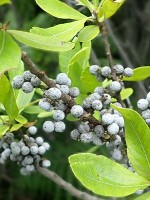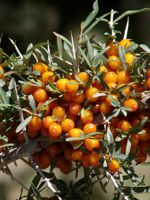Mon-Fri 9am - 5pm Mountain time
Northern Bayberry vs Orange Energy Sea Buckthorn (Female)
Myrica pensylvanica
Hippophae rhamnoides Orange Energy
NOT AVAILABLE THIS SEASON - MIGHT RETURN
Northern Bayberry makes an excellent hedge or feature shrub. It will retain its leaves in warmer climates but drops them in colder areas. They produce blue-grey berries that have a wax coating on them that can be used to make candles or soaps.
In colder hardiness zones the leaves turn an attractive orange to red colour in the fall, making it a striking addition to your landscape.
Northern Bayberry is native to Nova Scotia and tolerates both drought and wet conditions. It is also a nitrogen fixer that tolerates poor soil conditions.
Orange Energy Sea Buckthorn is a female variety known for its large yields of yellowish orange berries that ripen in September. The berries are juicy with a pleasant tart flavour. They have a high sugar content and are often sought after for their vitamin C concentration. Orange Energy Sea Buckthorn requires a male pollinizer to set fruit.
Orange Energy Sea Buckthorn has moderately thorny branches and other well-known features of Sea Buckthorn plants. These include silvery green foliage and nitrogen-fixing capabilities, which improves the surrounding soil.
Sea Buckthorn plants have male and female flowers occurring on different plants, a male pollinizer is required for fruit production. Can be paired with Lord Sea Buckthorn which is a male variety.
Northern Bayberry Quick Facts
Orange Energy Sea Buckthorn (Female) Quick Facts
Toxicity: Warning: The wax from bayberry fruit is considered toxic and may be carcinogenic.

